Navy starts 2016 by pinging in the pool (archived)
NOTE: Due to new information provided by the Canadian Navy, this post has been archived.
A new version with the most up-to-date and accurate information is available here — http://www.beamreach.org/2016/01/14/navy-starts-2016-pinging-in-the-pool
With transient killer whales in the area and the whereabouts of J and L pods (and their many newborns!) unknown, we were concerned to hear that active sonar was utilized late in the morning on Wednesday, January 13, in Haro Strait — critical habitat for species on both sides of the border. At the same time, military training activities were planned or taking place on both sides of the border. At the time the sonar was heard and recorded by members of the Salish Sea Hydrophone Network the Canadian Naval vessel HMCS Ottawa was transiting Haro Strait in U.S. waters.
This juxtaposition led us to initially assert that the Ottawa — a Halifax class frigate which carries active sonar — was the source of the sonar pings, reinforced by the activation of the test range (area Whiskey Golf off Nanaimo) on 1/12 and 1/14. However, a proactive call to Beam Reach on 1/14/16 from Danielle Smith, Environmental Officer for Canadian Forces Base Esquimalt, suggested that the Ottawa was not the source. Specifically, she stated that active sonar use was not in their plan when they last departed. She also said she spoke directly with the Ottawa’s Commanding Officer who confirmed with the crew the transducers were not lowered, and that therefore there was no way their SQS-510 (medium frequency search sonar system) could have transmitted (e.g. sometimes calibrations underway go unreported). Finally, she communicated that their senior sonar techs who said the recorded frequencies were not consistent with the Ottawa’s 510 system. When asked, she confirmed that the sonar system had not been upgraded since it was last recorded during the event in 2012 in which the Ottawa disturbed and possibly damaged the endangered Southern Resident Killer whales.
Other sources of information also suggest that the U.S. Navy may have been the source of the sonar pings.
First and foremost, the sonar pings are distinct from the active mid-frequency SQS-510 sonar used by the Ottawa in February, 2012. Instead, they sound similar to, but are more complex than the SQS-53C pings emitted by the U.S. destroyer Shoup on May 5, 2003.
They were also coincident with many individual broadband pings (classic submarine-movie ones) spaced about 6.6 seconds apart. Were these made by the vessel with the active sonar, or a different one?
Finally, comparison of the times of the recorded sonar pings and available AIS tracks suggests that the sonar was recorded when the Ottawa was located between the north Henry Island and Turn Point at the northwest tip of Stuart Island. If the source was the Ottawa, why would it have utilized sonar only while within U.S. waters (about 1-2 km east of the International Boundary). During this period, the Ottawa was about 8-16 km north of the recording hydrophones. Pending computation of the calibrated received levels, the qualitative intensity of the received pings suggests that the source was closer than the Ottawa’s AIS positions allow.
Smith’s statements and these observations raise a key question:Â were U.S. vessels in the area emitting these sounds that are similar to those emitted by the US destroyer Shoup in 2003?
This possibility is alarming because the U.S. Navy has refrained from training with active sonar within the Salish Sea since the Shoup sonar incident of 2003 (which disturbed endangered Southern Residents, as well as minke whale and harbor porpoises). (The U.S. Navy has tested sonar more recently, however, during the San Francisco submarine event of 2009 and the Everett dockside event in 2012.) Also, the U.S. Navy more recently has agreed to minimize the impacts of its mid-frequency sonar.
Portending a worrisome trend, at the start of 2016 news surfaced that the U.S. Navy planned operations in the Pacific Northwest that might include “mini-subs” and beach landings beginning in mid-January, 2016. At least one U.S. Naval ship, possibly the destroyer Shoup, was seen departing Everett around mid-day by Orca Network. No recent AIS tracks of US military vessels have been archived by marinetraffic.com, suggesting that the Navy vessels’ AIS transceivers may have been turned off based on their mission.
Below is a chronology of events, wildlife sightings, and acoustic analysis that we hope will help document the event, including the source of the sonar and any impacts on marine life of the Salish Sea.
Rough Chronology (local time, PST):
Tue 1/12/16 14:30 PST: Ottawa in search pattern all afternoon and night (1-7 knots, east of Constance Bank)
Wed 1/13/16 09:00 PST: Ottawa moves north into Haro Strait
Wed 1/13/16 10:00 PST: Ottawa enters U.S. waters, proceeds north
Wed 1/13/16 10:45 PST: Intense sonar pings recorded on the Orcasound hydrophone
Wed 1/13/16 11:00 PST: Ottawa leaves U.S. waters near Turn Point, Stuart Island
Detailed Chronology (public Google spreadsheet):
Acoustic recordings and analysis
Sonar sequence repeated 4 times around 11:00
Below is a 2-minute recording of the Orcasound hydrophone (by another hydrophone network citizen scientist) at 11 a.m. on 1/13/16 containing 4 sonar ping sequences. Each sequence lasts 30 seconds and contains a series of complex rising tones followed by single 3.75 kHz tones at about 9 and 22 seconds into the sequence.
Individual sonar ping at 10:55
Recorded and provided by another hydrophone network citizen scientist:
Individual sonar ping at 11:14
Recorded and provided by another hydrophone network citizen scientist:
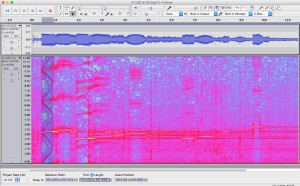
Spectrogram of 0.5 second sonar pings at 3.25, 6.5, and 9.75 kHz recorded on the Orcasound hydrophone.
Comparison with SQS-53C sonar pings from 2003 Shoup event
Ship tracks and descriptions
The Canadian frigate Ottawa was observed in Haro Strait at the time of the sonar pings. If the time of the recordings and AIS locations are accurate, then the Ottawa was approximately 8-16 km north of Lime Kiln and Orcasound when the sonar sounds were recorded at those hydrophone locations.
The Canadian Orca class patrol vessel, Caribou 57, was also active and tracked on AIS. From Tuesday 1/12 noon through 1/13 it was patrolling withing the southern Gulf Islands.
Possible US Naval ships in/outbound from Everett on 1/13/2016 (Skunk Bay web cam):

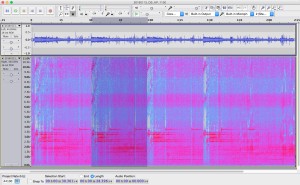

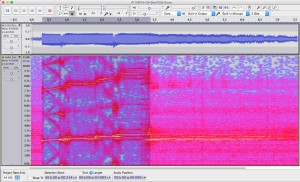
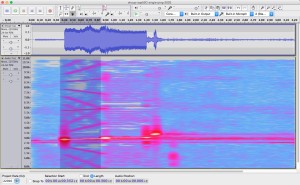
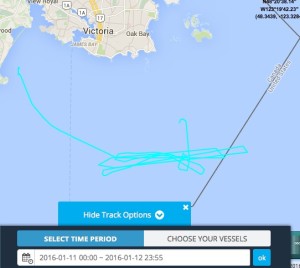
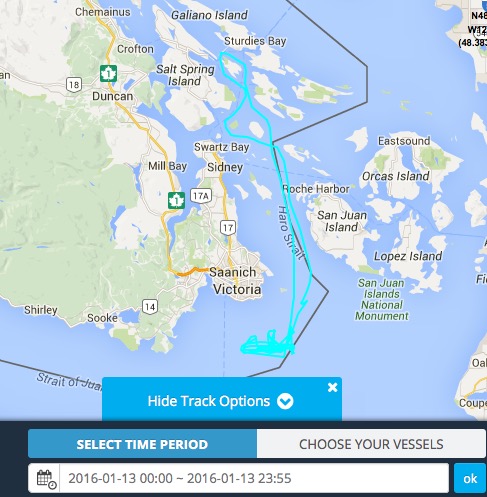
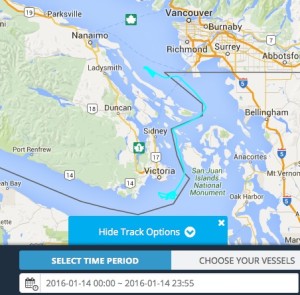
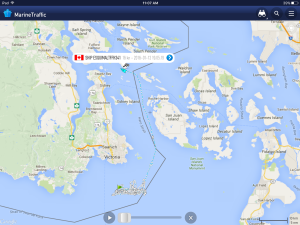
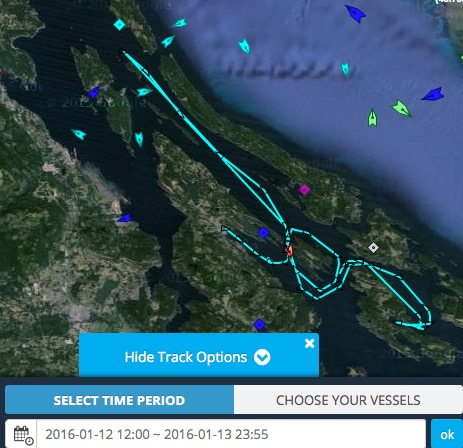
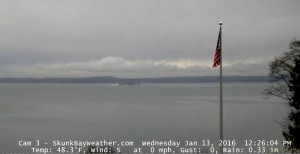
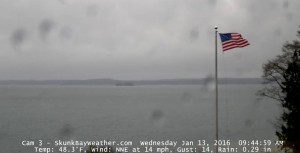


 Twitter
Twitter LinkedIn
LinkedIn Facebook
Facebook